Apple iPad 2 GPU Performance Explored: PowerVR SGX543MP2 Benchmarked
by Anand Lal Shimpi on March 12, 2011 3:04 PM EST- Posted in
- Smartphones
- Apple
- iPad
- GLBenchmark
- iPad 2
- Mobile
- Tablets
GLBenchmark 2.0
GLBenchmark 2.0—as its name implies—tests OpenGL ES 2.0 performance on compatible devices. The suite includes two long benchmarking scenarios with a demanding combination of OpenGL ES 2.0 effects - texture based and direct lighting, bump, environment, and radiance mapping, soft shadows, vertex shader based skinning, level of detail support, multi-pass deferred rendering, noise textures, and ETC1 texture compression.
GLBenchmark 2.0 is the best example of an even remotely current 3D game running on this class of hardware—and even then this is a stretch. If you want an idea of how the PowerVR SGX 543MP2 stacks up to the competition however, GLBenchmark 2.0 is probably going to be our best bet (at least until we get Epic to finally release an Unreal Engine benchmark).
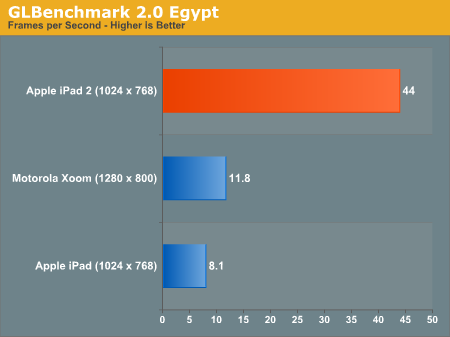
Without AA, the Egypt test runs at 5.4x the frame rate of the original iPad. It's even 3.7x the speed of the Tegra 2 in the Xoom running at 1280 x 800 (granted that's an iOS vs. Android comparison as well).
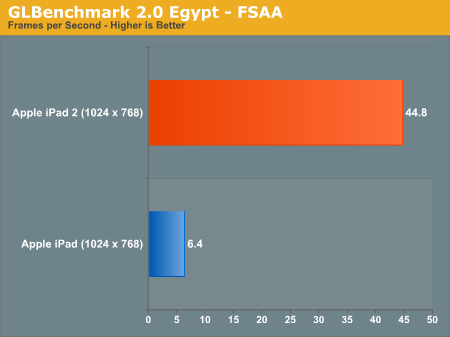
With AA enabled the iPad 2 advantage grows to 7x. In a game with the complexity of the Egypt test the original iPad wouldn't be remotely playable while the iPad 2 could run it smoothly.
The Pro test is a little more reasonable, showing a 3 - 4x increase in performance compared to the original iPad:
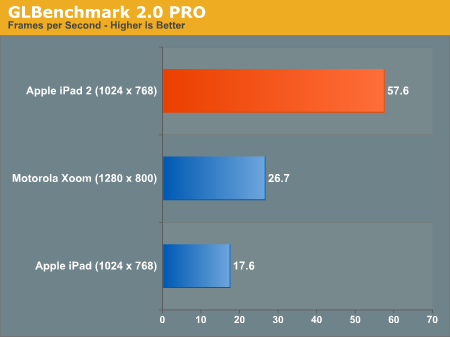
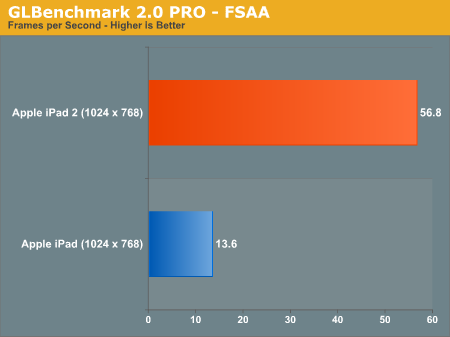
While we weren't able to reach the 9x figure claimed by Apple (I'm not sure that you'll ever see 9x running real game code), a range of 3 - 7x in GLBenchmark 2.0 is more reasonable. In practice I'd expect something less than 5x but that's nothing to complain about. We'll be doing power analysis over the weekend so expect more detail in our full review.
Putting the PowerVR SGX 543MP2 to Use: Infinity Blade
As we pointed out in our iPad 2 Preview, at least one developer already picked up on the amount of extra GPU horsepower in the new iPad 2. Epic put out an updated version of Infinity Blade with support for the iPad 2. Run it on an iPad and you'll get the same old Infinity Blade, but run it on an iPad 2 and you'll get more detail, higher resolution textures and anti-aliasing.
Remember that iPad and iPhone devices are more closed than your PC. There's no adjusting detail settings or resolution, so the target frame rate is usually what's fixed. Developers are simply able to deliver a better looking experience at roughly the same frame rate with upgraded hardware. In the case of Infinity Blade, load times are reduced thanks to the Cortex A9 CPU cores and there is some improvement in frame rate but the biggest impact comes from the improved visuals.
Below is the comparison beween Infinity Blade on the iPad and iPad 2 we ran in this morning's preview:
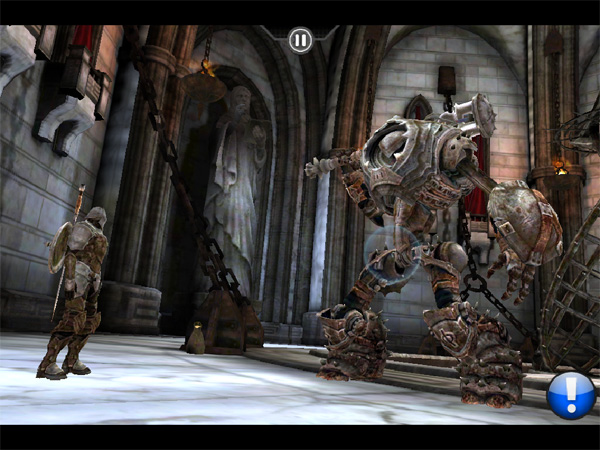
Mouse over to see Infinity Blade on the iPad 2
There's far more detail in the character models as well as the environment. Lighting looks improved and the AA is definitely appreciated.
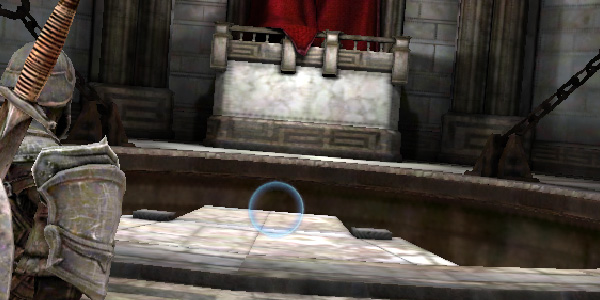
Mouse over to see Infinity Blade on the iPad 2
The gallery below has a bunch of side by side shots showing the improvements made to Infinity Blade for the iPad 2 vs. what you get when you run the game on a first generation iPad.
To Be Concluded...
We're still hard at work on our full iPad 2 review. We've got no less than four units running through battery life tests right now and there's still more to talk about in the review. We'll keep you posted, thanks for reading!


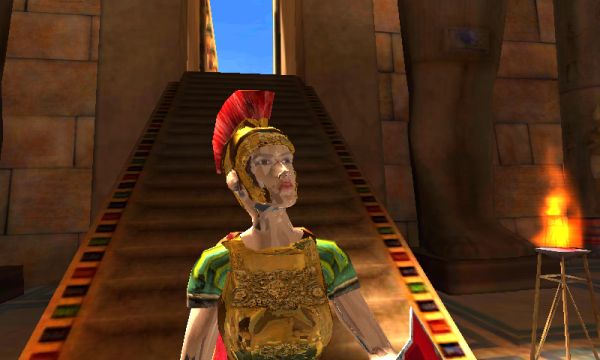














219 Comments
View All Comments
rish95 - Sunday, March 13, 2011 - link
iPad 1024 x 768 is 250% higher than smartphone 800 x 480. Xoom is only 30% higher resolution than iPad.AmdInside - Sunday, March 13, 2011 - link
Keep in mind, the Tegra2 is sort of an old product. And yes, the resolution difference is about 25%. I'm kinda of wondering if there will indeed be a Tegra3 tablet this year. One thing the iPad2 doesn't do well yet is multitask between multiple web pages.djgandy - Sunday, March 13, 2011 - link
How is it old? It's been on the market for a month.Some people think Nvidia are the only company who can make graphics chips.
pinisgrande - Sunday, March 13, 2011 - link
Dude, get your facts straight before you open your mouth.Nvidias tegra 2 is over a year old...
http://www.nvidia.com/object/io_1262837617533.html
It's just the manufacturers who didn't realize it's full potential util A MONTH ago.
Sry for my bad name but i regged just to post this comment
rish95 - Sunday, March 13, 2011 - link
But both the Tegra 2 and SGX543 were announced in 2009.Penti - Monday, March 14, 2011 - link
So was Cortex A9.Tegra 2 hasn't been shipping in products for long only from the late second half of 2010. For high-volume products at least. For that matter it was a year ago they began to produce SNB. So you have to differentiate ready for manufacturing and volume shipping products here. Doesn't mean either of them are old. It wasn't because they thought it would be fun they waited until now to produce dual-core tegra-2 phones.
djgandy - Sunday, March 13, 2011 - link
Its much better than Tegra. I'm sorry that Nvidia getting beat causes you so much heartache.Alexvrb - Monday, March 14, 2011 - link
No joke! I'm no fan of the iPad, but the SGX543MP2 destroys Tegra 2. There's a reason Sony went with the SGX543MP4, they saw its potential behind closed doors and knew it would smoke any available Tegra within their timeframe. Yes, Nvidia will release a newer one, but Sony can't afford to delay the NGP just because of the Tegra 3. Heck by then an SGX 6xx might be out.For those who don't know, the SGX543MP4 in the NGP has twice the cores of the SGX543MP2 tested here. Combine that with the other hardware of the NGP (faster processor, memory), slightly lower res screen (it's a 5" but its still supposedly 960 x 544 or something which is pretty high density), and big-budget titles should look really sick.
Raoush - Sunday, March 13, 2011 - link
ipad2 still quicker taking into account number of pixelsMore importantly - who cares about unimportant details like 3 fiddles vs 4 fiddles?
Computers are tools that perform tasks. What matters is the user's experience and the number of tasks they can perform.
The app store for me means that for this reason alone the iPad is only tablet worth getting. The fact that it's faster or slower than the Xoom (and it looks to be a lot faster) doesn't matter to me.
JPForums - Monday, March 14, 2011 - link
Agreed, at least in part.Due to resolution difference, the Xoom has 1.30 times the number of pixels if the iPad.
Assuming two equal chips and perfect scaling, the Xoom's frame rates should be about 76.8% that of the iPad's frame rates.
Clearly, there is a difference in optimizations and scaling isn't linear, but the differences here are large enough to indicate graphical superiority in Apple's hardware. (At least for these types of workloads)
I'd expect Tegra 3 to reverse the situation.
Considering how much faster nVidia updates than Apple, any advantage Apple gains will be relatively short lived.
On a side note, not all Cortex A9 designs are created equal.
nVidia for instances has elected to roll their own design rather that use prepackaged arm cores.
As such, they don't support NEON instructions in their Tegra 2 design.
I wonder if any of their design choices have limited their performance in some of these applications.